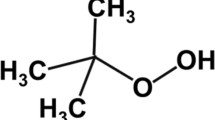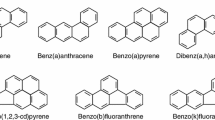Summary
Previous analytical studies of industrial samples of trichloroethylene (TRI) have revealed the presence of mutageneic and carcinogenic epoxides which, it was proposed, might be responsible for the carcinogenicity of such samples, as demonstrated with mice in other laboratories. To test this hypothesis, Swiss mice (ICR/HA) of both sexes, bred and kept in SPF conditions, were dosed daily with TRI in corn oil by gavage (males: 2.4 g/kg, females: 1.8 g/kg) with or without the addition of epichlorohydrin (EPC, 0.8%, w/w), 1,2-epoxybutane (BO, 0,8%), or EPC+BO (0.25%+0,25%) for 18 months. The ensuing observation period terminated at 106 weeks (from start of experiment). Gross and microscopic examination of all organs revealed a statistically significant increase in the incidence of forestomach papillomas and carcinomas after EPC-, BO-, and (EPC+BO)-stabilized samples of TRI, but not after pure, amine base-stabilized TRI. This type of tumor is believed to be induced by the direct alkylating epoxides epichlorohydrin and epoxybutane, whose industrial use in stabilizing chlorinated aliphatic hydrocarbons should be discontinued. No other significant increase in tumor incidences was found. Again, this study does not support the suggestion that trichloroethylene itself is carcinogenic under realistic exposure conditions.
Similar content being viewed by others
References
Bartsch H, Malaveille C, Barbin A, Planche G (1979) Mutagenic and alkylating metabolites of haloethylenes, chlorobutadines and dichlorbutenes produced by rodent or human liver tissues. Arch Toxicol 41:249–277
Bergmann K (1983) Interactions of trichloroethylene with DNA in vitro and with RNA and DNA of various mouse tissues. Arch Toxicol 54:181–193
Bonse G, Henschler D (1976) Chemical reactivity, biotransformation and toxicity of polychlorinated aliphatic compounds. CRC Crit Rev Toxicol 10:395–409
Cochran WG (1954) Some methods for strengthening the common chi-square tests. Biometrics 10:417–454
Cox DR (1972) Regression models and life tables (with discussion). J R Statist Soc B 34:184–220
Deringer MK (1959) Occurrence of tumors, particularly mammary tumors, in agent-free strain C3HeB mice. J Natl Cancer Inst 22:995–1002
Dunkelberg H (1982) Carcinogenicity of ethylene oxide and 1,2-propylene oxide upon intragastric administration of rats. Br J Cancer 46:924–933
Eaton GJ, Johnson FN, Custer RP, Crane AR (1980) The Icr:-HA(ICR) mouse: A current account of breeding, mutations, diseases and mortality. Lab Anim 14:17–24
Greim H, Bonse G, Radwan Z, Reichert D, Henschler D (1975) Mutagenicity in vitro and potential carcinogenicity of chlorinated ethylenes as a function of metabolic oxirane formation. Biochem Pharmacol 24:2013–2017
Henschler D, Eder E, Neudecker T, Metzler M (1977) Short communication. Carcinogenicity of trichloroethylene: Fact or artifact? Arch Toxicol 37:233–236
Henschler D, Romen W, Elsässer HM, Reichert D, Eder E, Radwan Z (1980a) Carcinogenicity study of trichloroethylene by long-term inhalation in three animal species. Arch Toxicol 43:237–248
Henschler D, Reichert D, Metzler M (1980b) Identification of potential carcinogens in technical grade 1,1,1-trichloroethane. Int Arch Occup Environ Health 47:263–268
Heston WE, Vlahakis G, Deringer MK (1960) High incidence of spontaneous hepatomas and the increase of this incidence with urethan in C3H, C3Hf, and C3He male mice. J Natl Cancer Inst 24:425–435
Konishi Y, Kawabata A, Denda A, Ikeda T, Katada H, Maruyama H, Higashiguchi R (1980) Forestomach tumors induced by orally administered epichlorohydrin in male Wistar rats. Gann 71:922–923
Laskin S, Sellakumar AR, Kuschner M, Nelson N, La Mendola S, Rush GM, Katz VG, Dulak NC, Albert RE (1980) Inhalation carcinogenicity of epichlorohydrin in non-inbred Sprague-Dawley rats. J Natl Cancer Inst 65:751–757
Mantel N (1963) Chi-square tests with one degree of freedom: extensions of the Mantel-Haenzel procedure. J Am Statist Assoc 58:690–700
Niosh (1976) National Occupational Hazard Survey. National Institute for Occupational Safety and Health, DHEW/PHS, Washington
Parchman LG, Magee PN (1982) Metabolism of (14C)trichloroethylene to14CO2 and interaction of a metabolite with liver DNA in rats and mice. J Toxicol Environ Health 9:797–813
Saffiotti J, Montesano R, Sellacumar AR, Cefis F, Kaufmann DG (1972) Respiratory tract carcinogenesis in hamsters induced by different numbers of administrations of benzo(a) pyrene and ferric-oxide. Cancer Res 32:1073–1081
Sabine JR, Horton BJ, Wicks MB (1973) Spontaneous tumors in C3H-A and C3H-AfB mice: High incidence in the United States and low incidence in Australia. J Natl Cancer Inst 50:1237–1242
Shahin MM, von Borstel RC (1977) Mutagenic and lethal effects of α-benzene hexachloride, dibutylphthalate and trichloroethylene inSaccharomyces cerevisiae. Mutat Res 48:173–180
Stott WT, Quast JF, Watanabe PG (1982) The pharmacokinetics and macromolecular interactions of trichloroethylene in mice and rats. Toxicol Appl Pharmacol 62:137–151
Van Duuren BL, Goldschmidt BM, Katz C, Seidman I, Paul JS (1974) Carcinogenic activity of alkylating agents. J Natl Cancer Inst 53:695–700
Author information
Authors and Affiliations
Rights and permissions
About this article
Cite this article
Henschler, D., Elsässer, H., Romen, W. et al. Carcinogenicity study of trichloroethylene, with and without epoxide stabilizer, in mice. J Cancer Res Clin Oncol 107, 149–156 (1984). https://doi.org/10.1007/BF01032599
Received:
Accepted:
Issue Date:
DOI: https://doi.org/10.1007/BF01032599




